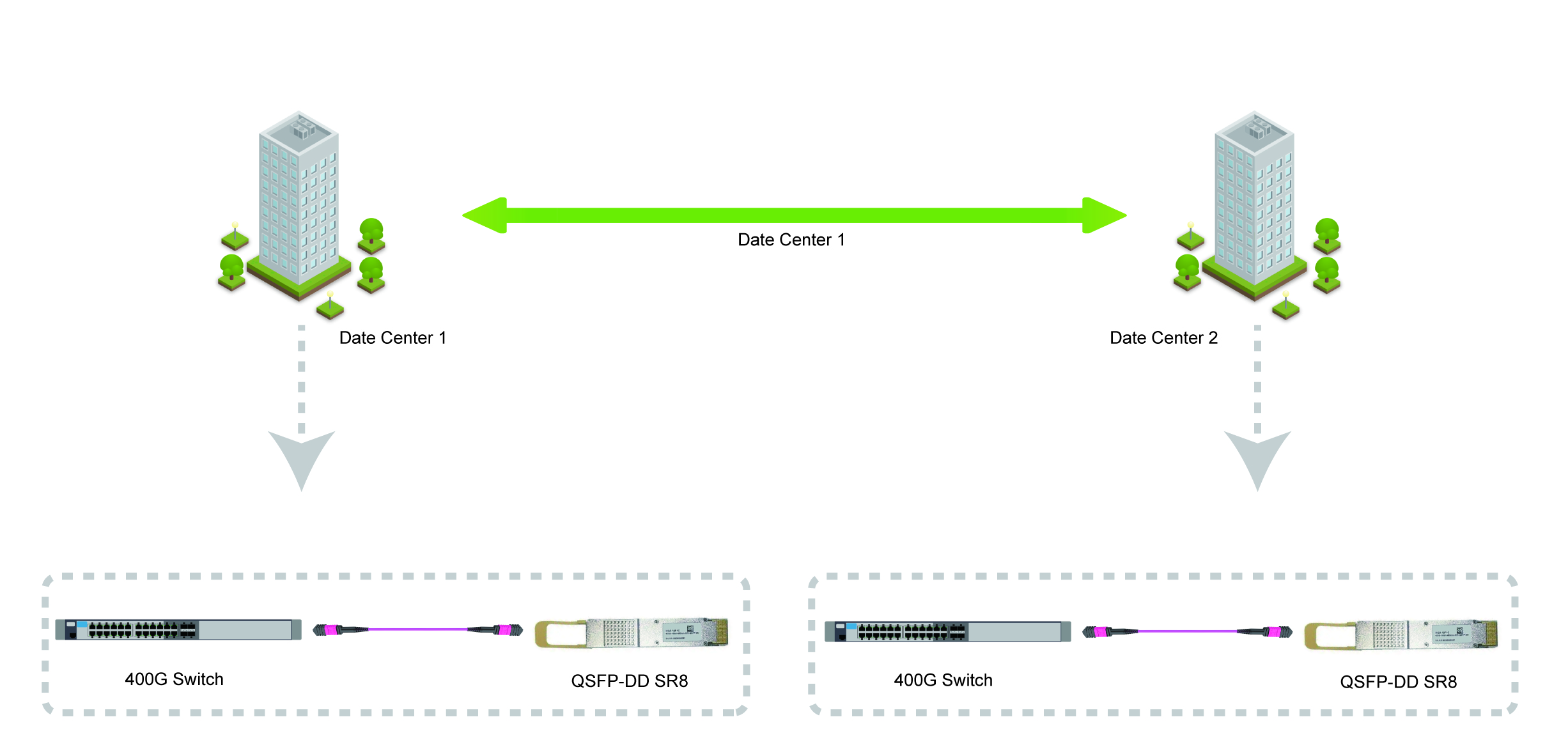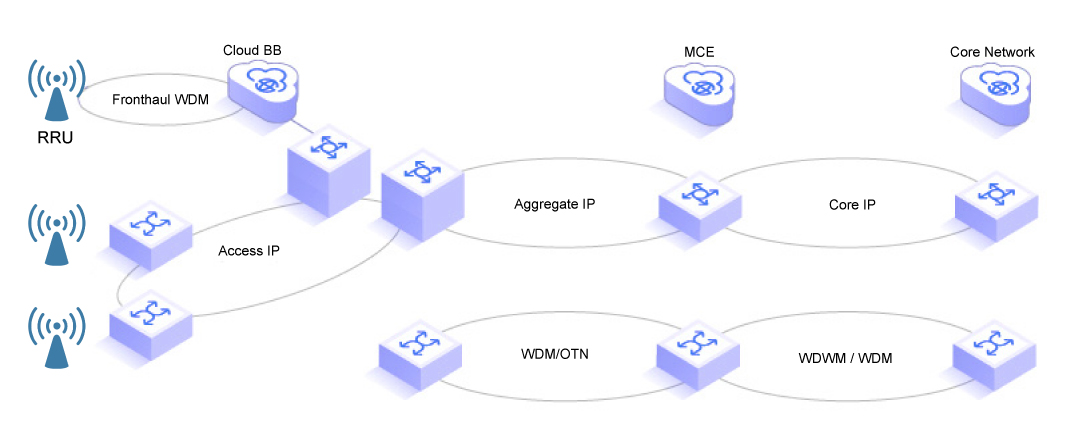Free Shipping on Orders over $99 for Whole USA

What are the Types of 400G Optical Transceivers?
What are the Types of 400G Optical Transceivers?
With the continuous growth of global data traffic, data center networks are being driven to upgrade from 100G to 400G. As a common, efficient, economical and practical application scenario solution in 400G networks, 400G optical transceiver can greatly improve system performance, increase transmission rate, broaden bandwidth and reduce broadband costs. Therefore, this article will mainly introduce 400G transceiver from aspects such as module packaging, scenario application and development trend.
Common 400G QSFP-DD Optical Module Types
There are eight common types of 400G QSFP-DD optical module on the market. The following article will give a basic introduction to QSFP-DD SR8, QSFP-DD DR4, QSFP-DD XDR4, QSFP-DD FR4, QSFP-DD FR8, QSFP-DD LR4, QSFP-DD LR8 and QSFP-DD ER8 optical modules.
400G QSFP-DD SR8
400G QSFP-DD SR8 is a 4-channel, hot-swappable fiber transceiver suitable for short-distance interconnection, which can support up to 70m (OM3) or 100m (OM4) multimode fiber links through MPO-16 connectors. It complies with the QSFP-DD MSA specification and IEEE 802.3bs protocol, including eight parallel transmission channels, each of which can achieve 400 Gbps data transmission at a transmission rate of 53.125 Gbps (PAM 4).
400G QSFP-DD DR4
The 400G QSFP-DD DR4 transceiver uses an MPO-12 connector to achieve a maximum transmission distance of 500m on a single-mode fiber (SMF) at a central wavelength of 1310nm. DR4 stands for "4-channel dense wavelength division multiplexing (DWDM)", indicating that the 400G DR4 optical module uses 4 channels to transmit data, each channel can transmit data at a rate of 106.25Gbps (PAM4), and the total transmission rate can reach 425G.
400G QSFP-DD FR4
400G QSFP-DD FR4 (full-duplex 4-channel, 4-level timing) is a hot-swappable optical transceiver that supports 400Gbps and can use LC connectors to support multimode fiber links up to 2km in length. The 400G FR4 optical module includes 4 independent channels, each with a rate of 100Gbps on the CWDM4 central wavelength, which complies with the 100G single-wavelength MSA specification and can be used in data center high-speed data transmission scenarios. The single-wavelength transmission rate based on PAM4 modulation can reach 106.25Gbps, achieving a total transmission rate of 400G.
400G QSFP-DD FR8
The 400G QSFP-DD FR8 uses the same 50G PAM4 modulation technology as the 400G QSFP-DD FR4 optical transceiver. It uses 8 channels to transmit data, with each channel having a transmission rate of up to 53.125Gbps and a total transmission rate of up to 400Gbps. Unlike the 400G QSFP-DD SR8 optical module, which is only suitable for short-distance transmission, the 400G QSFP-DD FR8 fiber transceiver can be used for medium-distance transmission, with a maximum transmission distance of 2km.
400G QSFP-DD LR4
400G QSFP-DD LR4 is an optical module with high transmission rate, high transmission bandwidth and long-distance data transmission, suitable for transmission application scenarios such as 400G Ethernet and data center interconnection. It supports single-mode fiber link lengths up to 10km through LC connectors and complies with IEEE 802.3bs protocol and QSFP-DD MSA standard.
400G QSFP-DD LR8
The modulation technology used by the 400G QSFP-DD LR8 transceiver module is the same as that of the 400G QSFP-DD SR8 and 400G QSFP-DD FR8 optical modules (50G PAM4 modulation technology), and it has 8 parallel transmission channels. However, compared with the 400G QSFP-DD SR8 and 400G QSFP-DD FR8 optical modules, each channel of the 400G QSFP-DD LR8 fiber transceiver can achieve up to 10km of single-mode fiber link transmission, with a maximum transmission rate of 106.25Gbps and a total transmission rate of 425G.
400G QSFP-DD ER8
The 400G QSFP-DD ER8 has the same transmission rate, modulation technology and connector as the 400G QSFP-DD LR8 optical module. It complies with the IEEE 802.3cn protocol and the QSFP-DD MSA standard. The only difference is the transmission distance. The 400G QSFP-DD ER8 transceiver can achieve a maximum transmission distance of 40km, so it is more suitable for ultra-long distance data transmission.
Application scenarios of 400G QSFP-DD Transceiver Modules
As a low-cost, low-power optical connection solution in the new generation of data centers, 400G QSFP-DD series transceiver module is widely used in scenarios such as data centers, metropolitan area bearer networks, and long-distance high-capacity transmission networks.
400G QSFP-DD optical module data center direct connection
In the data center network architecture, the connections between servers, between switches, and between servers and switches all require the use of optical modules, fiber optic patch cords, or other communication equipment to achieve network data interconnection. The following figure shows the direct connection of 400G QSFP-DD optical modules in data center application scenarios.

Metro bearer network
Factors such as cloud computing, big data, ultra-high-definition video, the Internet of Things, virtual reality/augmented reality, 5G, high-performance computing, and intelligent transportation have put forward new requirements for metro bearer networks: ultra-high transmission bandwidth, large data connections, ultra-low latency response, and high reliability. In the commercialization of 5G regional networks in large cities, the core layer bandwidth will be upgraded to 200GE/400GE because the traditional 100GE port can no longer meet the ultra-high bandwidth requirements of the 5G network aggregation layer and core layer. Therefore, the 400G-based optical interconnection solution has become an indispensable choice.

Long-distance and high-capacity transmission network scenarios
As new scenarios and applications emerge, the industry market has rapidly increased the demand for long-distance data transmission, further increasing the requirements for network transmission bandwidth. In addition, Internet operators have put forward higher standards for flexible network management and modulation. These changes in trends are driving the continuous upgrading of 400G applications in long-distance transmission. It can use a single 400G wavelength to connect 400G ports, adjust the wavelength path according to market demand, and realize direct wavelength access of the optical path to reduce latency and power consumption.

